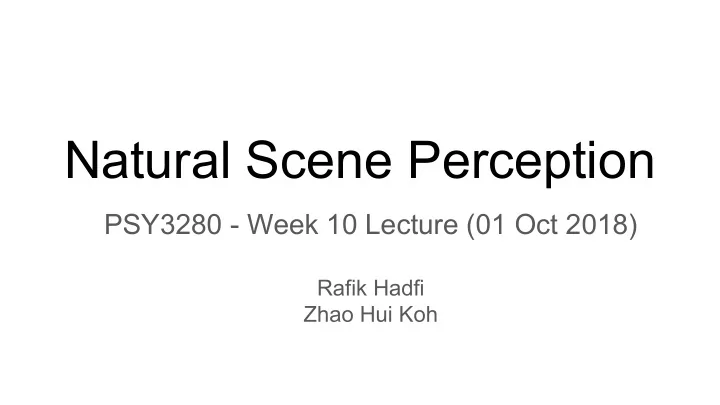

Natural Scene Perception PSY3280 - Week 10 Lecture (01 Oct 2018) Rafik Hadfi Zhao Hui Koh
Learning Objective - Natural Scene Human? Machine? Images retrieved from https://www.planetminecraft.com/project/minecraft-poem-scene/ and https://www.expedia.com/pictures/usa/washington-state.d249/
Natural scene - Human perception
Natural Scene 1 - Words to describe the image?
Natural Scene 2 - Words to describe the image?
Natural Scene 3 - Words to describe the image?
Richness of a natural scene (Fei-Fei et al., 2007) ● The content/information of Stage 1: Free Recall “gist” ● Objects, Physical Appearance, Spatial relations between objects ● Global semantic/context ● Hierarchical relationship (taxonomy) of object categories
Sample responses (Features and Semantic) Easy (Fei-Fei et al., 2007) Complex
Findings ● Richness of perception is asymmetrical (object and scene recognition) ○ Preference of outdoor (vs indoor) if visual information is scarce (small PT) ● Seem to be able to recognise objects at a superordinate category level (e.g. vehicle) as well as basic category levels (e.g. train, plane, car) ● Single fixation is sufficient for recognition of most common scenes and activities ● Sensory information (shape recognition) vs higher level conceptual information (object identification, object/scene categorisation) (Fei-Fei et al., 2007)
Quantify richness in visual experience ● Sperling’s experiment (1960) - limited capacity of phenomenal vision ● Limitations of past studies on richness of visual experience (Haun et al., 2017) ○ Controlled experiments - what a participant can report on (high-level categorical response, binary choice) ● “Participants were not asked” ● Previous paradigms have underestimated the amount of information available for conscious report from brief (Haun et al., 2017) exposures to the stimulus. Images retrieved from http://psychologyexamrevision.blogspot.com/2012/01/sperling-1960.html
Richness - Bandwidth of Consciousness (BoC) ● IIT - Information axiom - Distinguishable from every other possible experience ● How bits are measured ○ Information Theory - quantify bits of information (reduction of uncertainty) ○ Yes/no question from an image (presented for 1 second) - 1 bit of information ○ Past research - We can perceived up to maximum of 44 bits/second (Pierce, 1980) ● Honours Student’s Project - “A Moment of Conscious Experience is Very Informative” (Loeffler, Alon, 2017) ● Quantify the amount of information people can extract from brief exposure to a natural scene
Experiment ● Participants determined whether a word (descriptor) could describe the image (present and absent) ● Stimulus Onset Asynchrony (SOA - time between image onset and mask onset) ● Forced choice response (8 choices) ● Presence/Absence judgement + confidence rating (Loeffler, Alon, 2017)
Findings ● Participants’ feedback ○ Shorter SOA - bottom-up processing (features) ○ Longer SOA - top-down processing (semantic) (Loeffler, Alon, 2017)
Findings (cont’d) Exp 2 (10 questions/image) Exp 3 (20 questions/image) SOA: 133ms 52 bits/sec 100 bits/sec (Loeffler, Alon, 2017)
Natural scene - Machine perception
How machine sees image? Pixel matrices with RGB values Images retrieved from Nishimoto (2015) and https://www.ini.uzh.ch/~ppyk/BasicsOfInstrumentation/matlab_help/visualize/coloring-mesh-and-surface-plots.html
Machine learning in image perception ● Convolutional Neural Network (Image recognition & classifications, object detection, face recognition, cameras, robots) Apple Face ID ● Inspired by primate visual system (Week 9 Lecture) Images retrieved from https://support.apple.com/en-us/HT208109 and Van Essen, & Gallant (1994)
Convolutional Neural Network (ConvNet) Retrieved from https://medium.com/@RaghavPrabhu/understanding-of-convolutional-neural-network-cnn-deep-learning-99760835f148
Convolutional layer Filter Image Images retrieved from https://ujjwalkarn.me/2016/08/11/intuitive-explanation-convnets/ (Activation map/Feature Map)
Pooling layer ● Spatial reduction Images retrieved from https://ujjwalkarn.me/2016/08/11/intuitive-explanation-convnets/
“Show and Tell” - Natural scene captions Encoder Decoder Captions? (Vinyals et al., 2015; LeCun et al., 2015)
Recurrent neural networks ● Best for sequential input tasks - speech and language ● Process one element at a time and use hidden units to keep past history (feedback/recurrent) Outputs Inputs ● Machine translation (encoder + decoder) ○ English -> French ○ Image -> Caption (LeCun et al., 2015)
“Show, Attend and Tell” - Attention based (Kelvin et al., 2016; LeCun et al., 2015)
Discussion ● Can an artificial neural network (e.g. ConvNet) experience visual illusion, change blindness, binocular rivalry? ○ PredNet (Watanabe et al., 2018) Rotating Snake Illusion ● Is an artificial neural network conscious?
References ● Cadieu, C. F., Hong, H., Yamins, D. L. K., Pinto, N., Ardila, D., Solomon, E. A., et al. (2014). Deep Neural Networks Rival the Representation of Primate IT Cortex for Core Visual Object Recognition. PLOS Computational Biology , 10 (12), e1003963–18. http://doi.org/10.1371/journal.pcbi.1003963 ● Fei-Fei, L., Iyer, A., Koch, C., & Perona, P. (2007). What do we perceive in a glance of a real-world scene? Journal of Vision , 7 (1), 10–29. http://doi.org/10.1167/7.1.10 ● Haun, A. M., Tononi, G., Koch, C., & Tsuchiya, N. (2017). Are we underestimating the richness of visual experience?, 2017 (1), 817–4. http://doi.org/10.1093/nc/niw023 ● LeCun, Y., Bengio, Y., & Hinton, G. (2015). Deep learning. Nature , 521 (7553), 436–444. http://doi.org/10.1038/nature14539 ● Loeffler, Alon (2017). A Moment of Conscious Experience is Very Informative (Honour’s thesis). Monash University, Melbourne, Australia. ● Nishimoto, S. (2015). CiNet VideoBlocks movie library. Unpublished dataset. Pierce, J. R. (1980). Introduction to Information Theory - Symbols, Signals and Noise (2 nd Ed.). Mineola, NY: Dover ● Publications. ● Watanabe, E., Kitaoka, A., Sakamoto, K., Yasugi, M., & Tanaka, K. (2018). Illusory Motion Reproduced by Deep Neural Networks Trained for Prediction. Frontiers in Psychology , 9 , 1143–12. http://doi.org/10.3389/fpsyg.2018.00345 ● Van Essen, D. C., & Gallant, J. L. (1994). Neural mechanisms of form and motion processing in the primate visual system. Neuron , 13 (1), 1-10. ● Vinyals, O., Toshev, A., Bengio, S., & Erhan, D. (2015). Show and tell: A neural image caption generator (pp. 3156–3164). Presented at the 2015 IEEE Conference on Computer Vision and Pattern Recognition (CVPR), IEEE. http://doi.org/10.1109/CVPR.2015.7298935 ● Xu, K., Ba, Jimmy L, Kiros, R., Cho, K., Courville, A., Salakhutdinov, R., Zemel., R., Bengoi., Y. (2015) Show, attend and tell: Neural image caption generation with visual attention. Jmlr.org
Recommend
More recommend